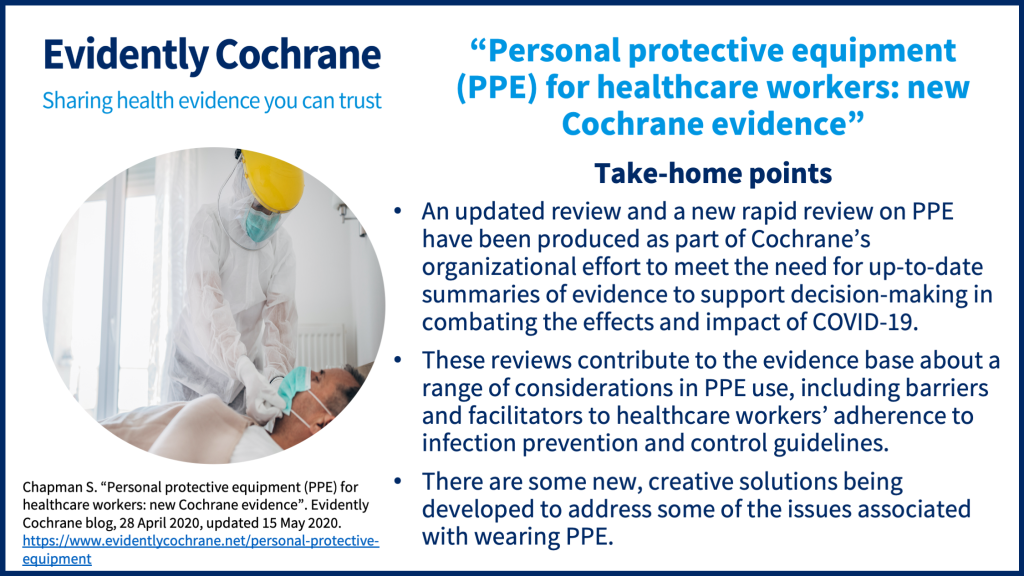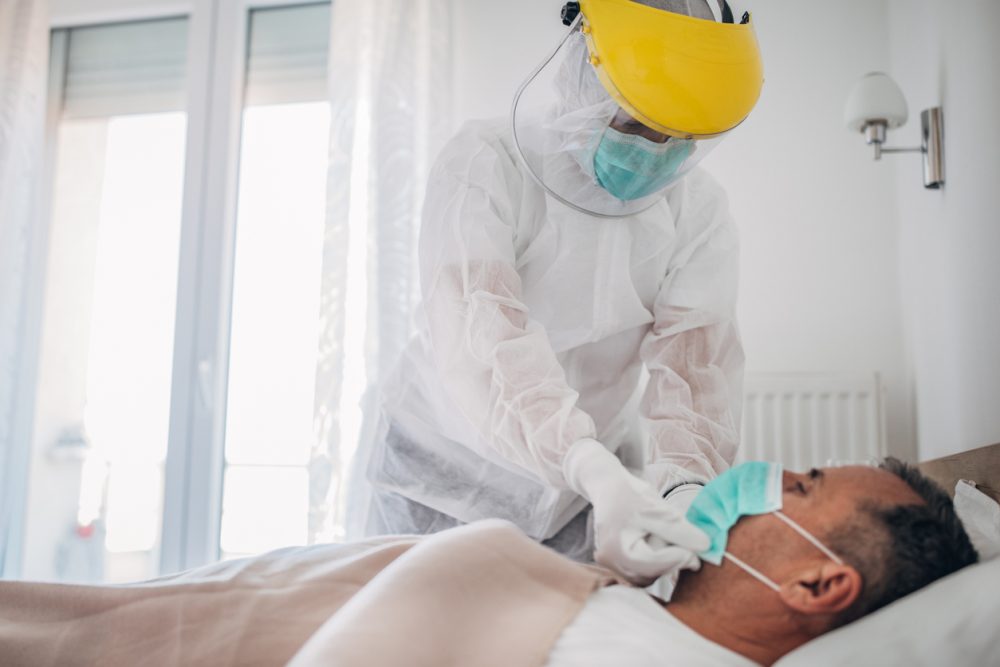Sarah Chapman looks at new Cochrane evidenceCochrane Reviews are systematic reviews. In systematic reviews we search for and summarize studies that answer a specific research question (e.g. is paracetamol effective and safe for treating back pain?). The studies are identified, assessed, and summarized by using a systematic and predefined approach. They inform recommendations for healthcare and research. on personal protective equipment (PPE) to protect healthcare workers from infections such as COVID-19 (coronavirus) and what influences them in how well they follow guidance for using it.
Page last checked 26 June 2023.
Take-home points

We’re hearing a lot about personal protective equipment, or PPE, at the moment. Whilst reducing the riskA way of expressing the chance of an event taking place, expressed as the number of events divided by the total number of observations or people. It can be stated as ‘the chance of falling were one in four’ (1/4 = 25%). This measure is good no matter the incidence of events i.e. common or infrequent. of infection to healthcare workers is of paramount importance, we are learning about some of the associated problems too. These include the obvious considerations around supply (is everyone getting PPE who needs it? How can we make sure there is enough?) but also a range of other concerns. I’ve heard from a nurse friend whose hot flushes are so severe that she cannot tolerate full body PPE and has to move to a different role, while others are finding that goggles and masks in particular are causing skin problems. I’ve seen commentary about the serious obstacle to communication that face masks create for people (including healthcare workers and patients) who are deaf or have hearing loss, and how frightening it can be to be cared for by people in full PPE. I’ve also seen some creative solutions addressing these things, more of which later.
Understanding a range of factors about PPE use, not just its technical capacity to protect the wearer from infection, is clearly important. Two Cochrane ReviewsCochrane Reviews are systematic reviews. In systematic reviews we search for and summarize studies that answer a specific research question (e.g. is paracetamol effective and safe for treating back pain?). The studies are identified, assessed, and summarized by using a systematic and predefined approach. They inform recommendations for healthcare and research. have very recently been published which contribute to the evidence base on PPE for healthcare workers.
One, on Personal protective equipment for preventing highly infectious diseases due to exposure to contaminated body fluids in healthcare staff has been updated with the addition of seven studies and revisions made to incorporate developments relating to COVID-19. The other, Barriers and facilitators to healthcare workers’ adherence with infection prevention and control (IPC) guidelines for respiratory infectious diseases: a rapid qualitative evidence synthesis, is a new rapid reviewA rapid review is a simplified systematic review that can be done in a few weeks to produce timely evidence for decision-making., one of a series produced in response to the COVID-19 pandemic. Both searched for studies to include up to March 2020.

What sort of PPE is this evidence about?
The Cochrane Reviews are concerned with medical grade PPE, used by healthcare workers. Different types of PPE are used but may include coveralls, gowns, hoods, masks, goggles and face shields, to prevent the wearer’s skin and mucous membranes from becoming contaminated, and respirators to prevent them inhaling infected particles. The purpose of this PPE is to protect the wearers from infection.
This evidence is not about the wearing of masks by the public, which is different. Aside from the difference in the technical specifications, these are expected not to protect the wearer but rather to protect others from droplet infection which could be spread by wearer.
Protective clothes and equipment for healthcare workers
The Cochrane Review on Personal protective equipment for preventing highly infectious diseases due to exposure to contaminated body fluids in healthcare staff (May 2020) explored the evidence on which type of full‐body PPE and which method of donning (putting on) or doffing (taking off) PPE have the least risk of contamination or infection for healthcare workers, and also which training methods increase compliance with PPE protocols.
The evidence comes from 24 studies (with 2278 people) assessed by the review authors as being of low- and very low-certaintyThe certainty (or quality) of evidence is the extent to which we can be confident that what the research tells us about a particular treatment effect is likely to be accurate. Concerns about factors such as bias can reduce the certainty of the evidence. Evidence may be of high certainty; moderate certainty; low certainty or very-low certainty. Cochrane has adopted the GRADE approach (Grading of Recommendations Assessment, Development and Evaluation) for assessing certainty (or quality) of evidence. Find out more here: https://training.cochrane.org/grade-approach, so they – and we – cannot be confident about the results. Studies were small and 18 of them did not assess healthcare workers treating infected patients but rather simulated the effect of exposure to infection. When future (hopefully better) studies can be added this may change the results.
The review authors found that while covering more parts of the body may give better protection there are trade-offs, as it may be more difficult to don and doff and be less comfortable to wear. More breathable PPE may lead to similar risks of contamination but be preferred by the wearer, while features such as tabs to grab may reduce contamination risk.

Donning and doffing must be done in the right way to reduce the risk of contamination. The review authors conclude that following Centre for Disease Control doffing guidance, a one‐step glove and gown removal, double‐gloving, spoken instructions during doffing, and using glove disinfection may reduce contamination and improve compliance. Face‐to‐face training in using PPE may lead to fewer mistakes than folder‐based training.
None of the studies looked at goggles or face shields. The best way to remove PPE after use, and the best type of training, remain uncertain.
Factors influencing whether healthcare workers follow infection prevention and control guidance
Some aspects of PPE use touched on in the above review are explored further in this new Cochrane rapid review: Barriers and facilitators to healthcare workers’ adherence with infection prevention and control (IPC) guidelines for respiratory infectious diseases: a rapid qualitative evidence synthesis.
The review authors looked for qualitative and mixed‐methods studies that focused on experiences and perceptions of healthcare workers towards factors that affected their ability to follow any infection prevention and control (IPC) guidelines for respiratory infectious diseases, in any setting.
They found 36 relevant studies and sampled 20 studies for their analysis. They explored the views and experiences of healthcare workers, mostly working in hospitals, dealing with severe acuteA health condition (or episodes of a health condition) that comes on quickly and is short-lived. respiratory syndrome (SARS), H1N1, MERS (Middle East respiratory syndrome), tuberculosis (TB), or seasonal influenza. Most of these diseases are similar to COVID-19 in the way they are transmitted. The review authors assessed the evidence as being of moderate to high certainty.
Healthcare workers identified several factors that impacted on their willingness and ability to follow IPC guidelines when managing respiratory infectious diseases:
The guideline itself and how it is communicated
Healthcare workers saw clear communication about guidelines as vital. Frequent changes to local guidelines could leave them feeling overwhelmed, and they were unsure how to follow them when they differed from national/international guidelines, or were long or unclear.
Support from managers, and workplace culture
Healthcare workers said their responses to guidelines were influenced by the level of support they felt they received from their managers. They also highlighted the influence of workplace culture around PPE and the importance of including all staff when implementing IPC guidelines.
Training
Healthcare workers thought it was a problem when training was not mandatory, as was a lack of training about the infection they were dealing with, and on how to use PPE.
Access to and trust in personal protective equipment
A lack of PPE, and poor quality PPE, were concerns for healthcare workers and managers. They commented on the need to adjust supplies throughout the course of an outbreak of infection.
A desire to deliver good patient care and other motivations
Healthcare workers felt they were motivated to follow IPC guidance more closely when they saw the value of it, and by fear of infection (for themselves and their families) and a sense of responsibility for their patients.
Some problems associated with wearing PPE…
Healthcare workers mentioned that wearing PPE could be uncomfortable and also that it could make patients feels isolated, frightened or stigmatised.
We have been seeing reports of this, as I mentioned at the start, along with the communication difficulties for people who rely on lipreading or other visual cues, and unmuffled speech, to understand what is being said. Which brings me on to…
… some creative solutions
It’s said that necessity is the mother of invention and so it is with our current crisis. Many healthcare workers are wearing large badges with their name and photograph, so that their patients can see who the person is under the ‘disguise’ of PPE.
The problem of PPE being hot to wear is not new of course, but new solutions are being devised. University Southampton Hospital has rapidly developed and introduced a new type of respirator hood for staff treating people with coronavirus. Among its advantages are a fabric hood and clear plastic front, and the delivery of clean air through a High Efficiency Particulate Air (HEPA) filter with belt-mounted fan pack.
Using a mask or hood with a clear panel making visible the wearer’s mouth is one way of addressing the difficulties opaque face coverings present for people with hearing problems, but they won’t be available to many.* A solution at hand for many more is a new, free app, developed this month by an NHS doctor, Rachael Grimaldi, after reading about a patient with COVID-19 who could not understand what healthcare workers were saying because of their PPE. She came up with Cardmedic, an online index of digital flashcards to aid communication with patients, available in 10 languages. Brilliant.
Innovations such as these look set to improve things for staff and patients beyond the time of crisis that produced them, and we may yet see more.
As for Cochrane, our response to the COVID-19 pandemic includes making access to the Cochrane Library free for all, producing new reviews and updating others relevant to COVID-19, and putting together a series of special collections. Cochrane also has a COVID-19 StudyAn investigation of a healthcare problem. There are different types of studies used to answer research questions, for example randomised controlled trials or observational studies. Register of primary studies to support rapid evidence synthesis by all systematic reviewIn systematic reviews we search for and summarize studies that answer a specific research question (e.g. is paracetamol effective and safe for treating back pain?). The studies are identified, assessed, and summarized by using a systematic and predefined approach. They inform recommendations for healthcare and research. producers, including Cochrane’s work on Rapid Reviews in response to COVID-19. Find out more about Cochrane resources and news on COVID-19.
*Editor’s note: According to a press release on 05 September 2020 from the UK Department of Health and Social Care, 250,000 clear face masks are to be delivered to frontline NHS and social care workers to support better care for people who use lip-reading and facial expressions to communicate.
Join in the conversation on Twitter with @CochraneUK @SarahChapman30 or leave a comment on the blog. Please note, we cannot give specific medical advice and do not publish comments that link to individual pages requesting donations or to commercial sites, or appear to endorse commercial products. We welcome diverse views and encourage discussion but we ask that comments are respectful and reserve the right to not publish any we consider offensive. Cochrane UK does not fact check – or endorse – readers’ comments, including any treatments mentioned.
References and related resources (pdf).
Sarah Chapman has nothing to disclose.
*Photo credit: Flickr by DFID – UK Department for International Development at cc-by-2.0.



Hey there, I enjoy reading your website! I can totally relate to your point as I am currently employed as a virtual nurse for an outsourcing company.